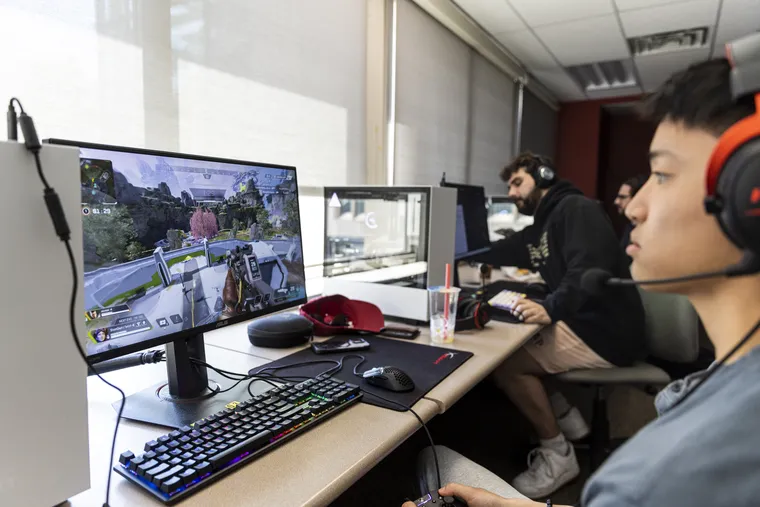The blinds were drawn; gaming keyboards in rainbow colors lit up long tables. The sound of clacking keys and snatches of bizarre conversation filled the narrow room.
“I got stuck so insanely hard.”
“Do I have assistance?”
“Oh, rude.”
On a recent Friday afternoon in the new esports room at Temple University, team practice was underway.
“Whenever I meet anybody, I tell them I’m basically a D-I athlete — D-I esports,” joked Cole Murray, a 22-year-old senior, as he maneuvered a ball in the video game Rocket League. But it’s not really a joke. Murray is a varsity player with an esports scholarship, a reality that was probably unthinkable a decade ago.
College esports — where highly-skilled gamers face off for titles and prize money in front of enthusiastic fans — are increasingly popular at schools nationwide, with administrators looking for ways to capitalize on a new generation’s devotion to video games.
“Traditional” sports, as gamers refer to them, are enormously valuable for universities, fostering school spirit, generating revenue through ticketing, broadcast deals, and sponsorships, and helping to recruit new students, said Jeffrey Levine, a professor of sports business at Drexel University. (The recruitment boost is called the “The Flutie Effect” after a particularly talented Boston College quarterback in the 1980s).
Esports aren’t there yet — but schools are starry-eyed about the possibilities.
Some, like Kutztown University and Waynesburg University, have recently opened esports arenas — concert-like venues where student fans can watch highly-produced live gaming tournaments. This week, Rowan University opened a 7,100 square foot esports venue on campus in partnership with Nerd Street Gamers, a Philly-based esports company.
Rowan’s administrators said gaming is “immensely popular” with students. But they also have grander aspirations. They hope that investing in esports now will give students a leg up in a wide range of “highly technical, computer-based fields,” from agriculture to the military.
“The entire global economy is going digital, and that’s why we’re doing it,” said the school’s president, Ali Houshmand, at a ribbon cutting ceremony for the new space.
Last month, Temple partnered with Nerd Street to give its players free access to a practice space called The Block; earlier in the year, Wayne Mackey, a Temple alum and successful gamer, donated funds for 13 esports scholarships and for a sleek new practice room at the school.
It’s a popular investment with students, and universities also see esports as “buzzy,” said Ashley Dabb, head of American operations for Red Knot Communications, a Cherry Hill-based PR firm that partly specializes in esports.
Still, college gamers often find themselves defending what they do.
Ethan Cantor, in-game leader for Temple’s Apex Legends team, recalled mentioning his hobby to his aunt, a big football fan, at Thanksgiving a few years back.
“What about real sports?” she asked.
“That’s not nice,” said Cantor, 23, who is a music technology major. “Esports are sports.”
To be a star, according to the pros, a gamer must have quick reflexes, highly-tuned fine motor skills, intense concentration, and an encyclopedic knowledge of the game.
In Cantor’s game, Apex Legends — a 60-person Battle Royale similar to The Hunger Games — that means memorizing thousands of spots on an ever-shifting map. A competitive college gamer also must be disciplined, preparing for weekly matches in hours-long practices sessions.
Cantor started played casually in a league with friends back in 2020. Then they won the league — and he realized he might be able to play competitively.
He’s now skilled enough that he was invited to practice in an Apex pro-league featuring the top players across North America, which holds open practice for 6 hours each day. (His teammate likens it to running practice games with the NFL). He estimates that he plays Apex for about 30 hours a week.
Similar to a traditional athlete, Cantor aims to eat three meals a day and get 8 hours of sleep when he is competing. Perhaps dissimilar to traditional athletes, he and his teammates clean their rooms before game day, since it pretty much serves as their field during a tournament.
Because esports are still in their infancy, there’s no clear pathway for college-level recruitment and no rules about what exactly coaches can and can’t do to encourage enrollment, Levine said.
Michael Martin, 22, Temple esport’s president, said parents of high schoolers have reached out about the quality of the esports program for their children.
“They want to be on the best team possible,” Martin said.
That lack of formal structure, as well as widespread harassment of female players at the “grassroots” level, contributes to the highly skewed gender makeup of the college gaming world, Levine said. Ninety two percent of college esports players are men, according to data from the National Association of Collegiate Esports.
At Temple, there is one woman on the Rainbow Six Siege team, Martin said. (He said there were more women who participate in casual gaming with the club).
Esports will not eclipse college football anytime soon — Murray’s scholarship, after all, is for $2,200. While they await the day, college administrators continue to invest in the nascent industry and college gamers continue to rack up playing time.
“How many hours do you think you have total?” Cantor asked his teammate Stephen Nackman, a 21-year-old junior, as they waited for the game to load. Apex was first released in February 2019, and both have been playing since then.
“Across all the systems?” Nackman asked. “It’s gotta be at least 4000.”
“At least 4000 hours?” Cantor reflected. “I’m probably approaching six, I think.”
